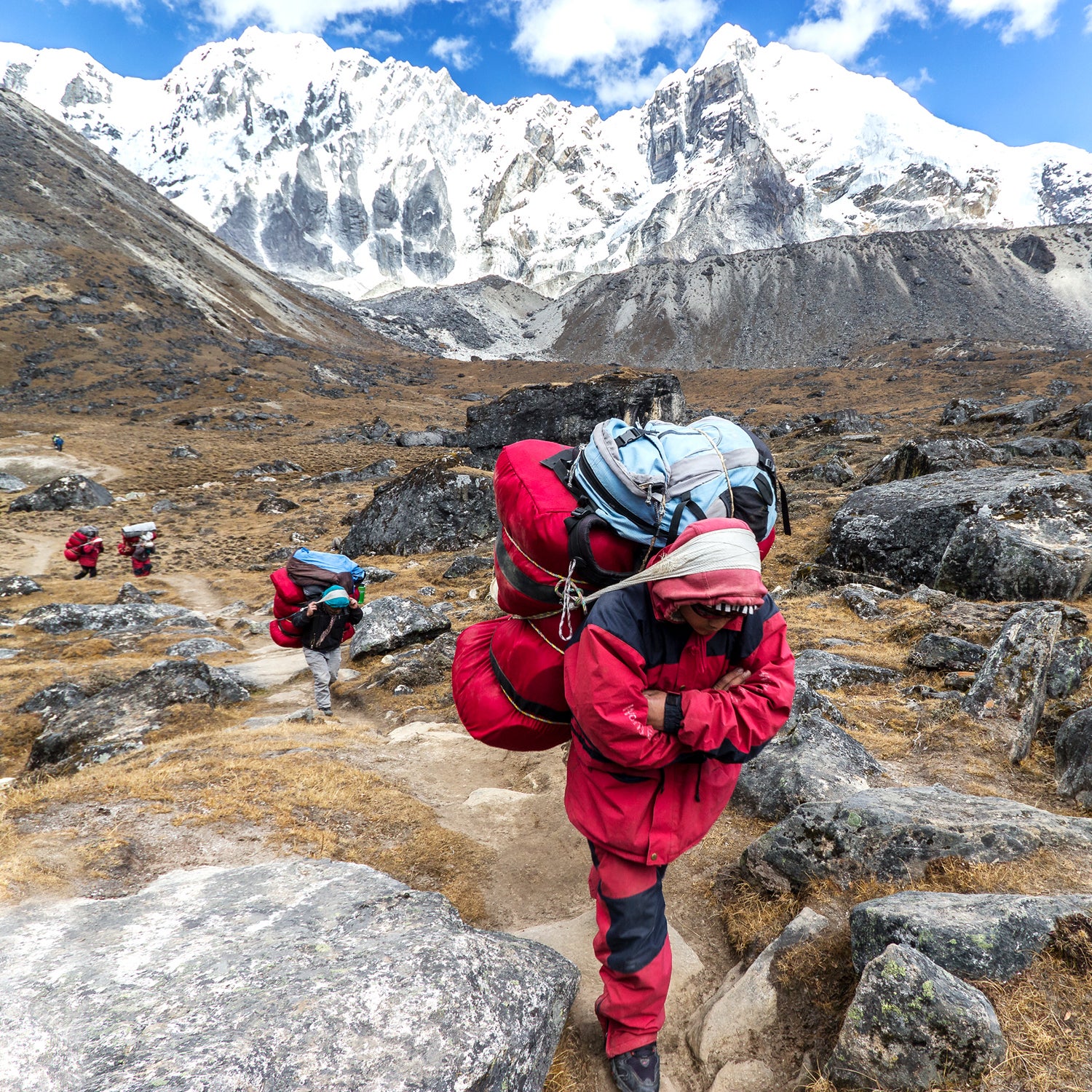Going through the Khumbu Icefall on Mount Everest is like playing Russian roulette, I am told. Sherpas, who make as many as 40 trips per season through this treacherous area, know the odds are stacked against them.
On this day one year ago, 16 men died in an instant during an avalanche in the Icefall. Sixteen families lost their sole breadwinners and 31 children lost their beloved fathers. The face of grief captured on a young Sherpa girl’s face at her father’s funeral—an image circulated in newspapers around the world—served as a reminder to climbers that mountaineering can be a deadly business.
A Sherpa gets paid about $32.50 per round trip carrying heavy loads through the Icefall. (This Icefall bonus comprises part of the roughly $4,000 to $6,000 that a Sherpa makes in a season on the mountain.) The supplies Sherpas bear ensure that the climbers have what they need higher up on the mountain, that their energy is conserved, and that their chances of making it to the top of the world are much higher.
Dorje Sherpa was one of the 16 who died. He was married to Ang Nemi Sherpa, whom my grandfather raised. Last October I saw Ang Nemi in Namche Bazaar. She had made the trek from the tiny hamlet of Tragna at 13,000 feet. She lives in a traditional one-room stone hut with baby yaks on one side of the room and her family on the other. I asked her how she was coping. She was bereft of words. Her four young children are attending school in Namche Bazaar, thanks to money provided by Lakpa Rita Sherpa, a veteran climber and guide for , Dorje’s former employer. She longs to relocate closer to her children, and the community is helping her make this possible.
Yes, Sherpas make a choice to risk their lives to feed their families, but this equation can be changed, and the inequity can be reduced.
To use the words of the great climber Pete Athans, last year’s tragedy inspired “” for those who work on the mountain. I would like to think that it was also a referendum on inequity; for the first time, the troubling inequity between risk and reward on Everest was under a global microscope. Yes, Sherpas make a choice to risk their lives to feed their families, but this equation can be changed, and the inequity can be reduced. Western guides earn about ten times the income of Sherpas for guiding on Everest.
A shift began in late August, when 40 mountaineering workers with a range of experiences came together to discuss the issues they faced on climbing expeditions. It was a unique gathering and event. In an industry dominated by the agendas of international climbers and expedition companies, Sherpas are not typically invited to share their opinions on necessary reforms. The workers made seven recommendations, among them were access to more professional training opportunities, the need to reform overly-competitive business practices that encourage cuts in price and safety, and the need to instill better employment practices.
In response to the call for crucial changes to the industry, the Nepali Government, which received $3.2 million in mountaineering fees from Everest climbers in 2014, revealed its position on ordinary Sherpa lives by increasing life insurance premiums by an insignificant amount ($5,000), offering a pittance in compensation (an additional $400 per family), and instituting lightweight changes on the mountain, like slightly increasing the presence of officials at Base Camp. More substantive support—funds to educate children, cost of living stipends for the widows—came from coordinated efforts of a number of non-profit organizations.
Every day the relatives of the men who died last year face their grief. How then can one explain to a young child that his or her father died on Everest so that an autographed ball can be carried to the summit for the bargain price of $32.50?
On Saturday, homes around the Himalaya marked the first anniversary of the deaths of their loved ones with Buddhist rituals: clouds of fragrant juniper will hang over villages; butter lamps will be lit; the haunting sounds of long Buddhist horns and cymbals will reverberate across the valleys; and generous offerings will be made in memory of the fallen, and in the hope that the lives of Sherpas will mean as much as that of the people they assist to the top of Everest. But while the global Sherpa community unites in support for the families, Chomolungma (“mother goddess of the world”) continues to become more of a playground: this year, one of the 30 expeditions on Everest intends to place a player-autographed Premier League football on the summit. Kailash Sirohiya, Managing Director of the local Nepali media conglomerate Kantipur Publications touts this as a “truly innovative campaign,” which will “put Nepal and Mount Everest’s name on the world map.”
Every day the relatives of the men who died last year face their grief. How then can one explain to a young child that his or her father died on Everest so that an autographed ball can be carried to the summit for the bargain price of $32.50? The results of the referendum on risk have come too soon, and people with the power to decide have voted for business as usual.
Norbu Tensing Norgay is the son of Nepalese mountaineer Tenzing Norgay, one of the two first people to summit Mount Everest, in 1953.


